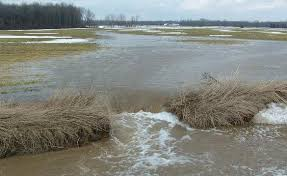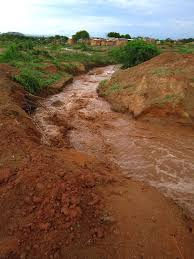Science > Biology > Soil Management > Soil Erosion
The removal of the top fertile layer of the soil from the soil is called soil erosion. It is a naturally occurring process that affects all landforms. In agriculture, soil erosion refers to the wearing and transportation of topsoil of the field by the natural physical forces of water and wind or through forces associated with farming activities such as tillage. It can be a slow process that continues relatively unnoticed or can occur at an alarming rate, causing serious loss of topsoil. It takes place in three steps first soil detachment, second the movement and third the deposition. Topsoil, which is high in organic matter, fertility and soil life from one place is relocated elsewhere at the shallow basin. Here the soil it builds up over time and fills in drainage channels.
Causes of Soil Erosion:
Rainwater and Runoff:
Greater duration and intensity of rainstorm means greater potential for soil erosion The impact of raindrops on the soil surface can break down soil aggregates and disperse the aggregate material. Rain produces four major types of soil erosion including rill erosion, gully erosion, sheet erosion, and splash erosion. The lighter aggregate materials like fine sand, silt, clay and organic matter get removed by the impact of raindrop and runoff water. The rate of soil erosion is noticeable during high-intensity rain pour. The soil erosion due to less intense rain is not noticeable over a short time but its effect can be seen over a long period.

Flow of Rivers and Streams:
The flow of rivers and streams causes erosion. The water flowing in the rivers and streams tend to take away the soils along its path. It leads to increased pollution and sedimentation in streams and rivers, clogging these waterways and causing declines in fish and other species.

Gust of wind:
High winds can contribute to the erosion of soil, particularly in dry weather periods or in the arid and semi-arid regions. The wind picks up the loose soil particles with its natural force and carries them away to far lands, leaving the soil sculptured and denudated.

The possibility of the erosion of soil increases for a land which has a less vegetative cover. Thus less vegetative cover is one of the main cause of soil erosion.
Overgrazing and Overstocking:
Overgrazing is one of the causes of erosion. Overgrazing reduces the usefulness, productivity of the land. The livestock press the subsoil into fine soil which can be carried easily by wind and water. Reduced soil depth, soil organic matter, and soil fertility affect the land’s quality and agricultural productivity.
Tillage Practices:
The potential for erosion by water is affected by tillage operations, depending on the depth, direction, and timing of plowing, the type of tillage equipment and the number of passes. Agricultural tillage depending on the machinery used also breaks down the soil particles, making the soils vulnerable to erosion by air and water. Up and downfield tillage practices as well as create pathways for surface water runoff and can speed up the soil erosion process. Minimum till or no-till practices are effective in reducing soil erosion by water. Cross-slope cultivation and contour farming techniques discourage the concentration of surface water runoff and limit soil movement.
Deforestation and Urbanization:
The loss of trees, which anchor the soil with their roots, causes widespread erosion. Deforestation and urbanization destroy the vegetation land cover. Agricultural practices such as burning and clearing of vegetation also reduce the overall vegetation cover. Due to the lack of land cover the rate of soil erosion increases.
Impact of Soil Erosion:
- Lands used for crop production gets substantially affected by soil erosion. Soil erosion removes valuable topsoil which is the most productive part of the soil profile for agricultural purposes. The loss of this topsoil results in lower yields and higher production costs.
- Eroded soil, contains nutrients, fertilizers and herbicides or pesticides. These constituents sediment in an area where there is a reduction in the slope of the land i.e. along contour banks, or in grassed waterways, dams or wetlands.
- Eroded soil, contains nutrients, fertilizers and herbicides or pesticides. These constituents lead to water pollution and damage to marine and freshwater habitats.
- Soil erosion due to wind picks up dust particles of the soil and throws them into the air, causing air pollution. Some of these dust particles may contain harmful and toxic particles.
- Soil erosion can affect infrastructural projects such as roads, dams, drainages, and embankments. The accumulation of soil sediments in dams/drainages can reduce their operational lifetime and efficiency. Roads carrying major transport may get washed away.
- Soil erosion is a major driver of desertification. It gradually transforms a habitable land and the Arid and Semi-arid lands (ASAL) regions into deserts.
Types of Soil Erosion:
Sheet Erosion:
Uniform removal of a thin layer of soil from a large area is called sheet erosion. It is affected by run-off effect of rain water.

Rill Erosion:
In this type of soil erosion, heavy rainfall and rapidly running water produce finger-shaped grooves or rills over the entire field. Rill erosion results when surface water runoff concentrates in the region where the soil is loosely attached compared to rest of the region. Small yet well-defined channels are formed from where the soil has been washed away. These channels are called rills.

Gully Erosion:
When the width of the rill erosion increases it is referred as gully erosion and it becomes an alarming factor. It is a more prominent type of erosion in which heavy rainfall, rapidly running water and transporting water may result in deeper cavities or grooves called gullies. Gullies may be ‘V-shaped or ‘U’ shaped. Gullies cut the fields into small fragments and make them uncultivable

Bank Erosion:
On the banks of swollen rivers, it is most active. Natural streams like rivers and constructed channels act as outlets for surface water runoff. Bank erosion is a progressive undercutting, scouring and slumping of these drain ways. During the rainy season when fast running water streams take a turn in some other directions, they cut the soil and make caves in the banks. As a result of this, quite often large masses of soils become detached and washed away from the banks.

Tunnel Erosion:
This is an insidious (n9on noticeable) form of erosion in some soils where channels and tunnels develop beneath the surface. When water penetrates through a soil hole created due to the decay of root, the soil disperses and is carried away with the flow to leave a small tunnel. Initially, the surface is intact but with a continuous flow of water the size of the tunnel increases. Ultimately it collapses to form gully.

Mass Movement of Soil:
Mass movements like soil creep, earthflow, slumping, landslips, landslides, and rock avalanches occur on cleared slopes in coastal and hilly areas. The soil starts moving under the action of gravity it may be slowly or sudden. This type of soil erosion is caused by heavy rainfall and it occurs in sloppy lands, such as mountains and hills. In this type of erosion when the running water percolates through the crevices of rocks great masses of soils and loose rocks lying on the steep slopes slip downward.

Wind Erosion:
Removal of soil by wind is called wind erosion. Stormy winds carry the soil particles to distant places and sometimes form sand-dunes. It is most likely to occur in a region where strong winds blow over light-textured soil which has been heavily grazed.

Previous Topic: Testing of Soil On-farm Methods
Next Topic: Prevention of Soil Erosion
2 replies on “Soil Erosion”
Thanks
Well understanding